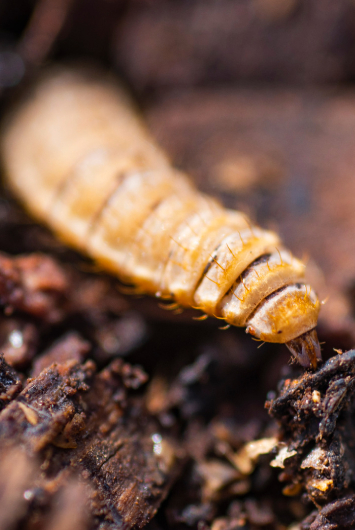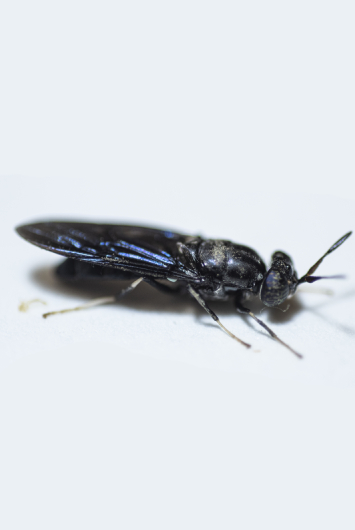HERMETIA ILLUCENS
"Hermetia illucens” or "black soldier fly - BSF" belongs to the phylum Arthropoda, class Insecta, order Dipteraand family Stratiomyidae. It is native to America but has a cosmopolitan distribution in tropical and warm temperate regions. Since BSF larvae feed on a wide range of decomposed organic material, they are used in forensic entomology to recognize the minimum post-mortem interval of a dead body.
In recent years, BSF species have captured the attention of the scientific research and insect industry, due to their very short rearing cycle (about 40 days) under optimal temperature conditions (29±0.5°C; 60±5% RH) and simplicity of the life cycle management. With the introduction of recent legislative authorizations (Reg. No. 2017/893), it is possible to take advantage of the natural ability of BSF larvae to bio-convert a wide range of organic material, such as vegetable by-products (but also animal by-products such as eggs or milk derivatives, honey, and by-products of non-ruminant animals), into high biological value proteins (36-48% on a dry matter basis). Furthermore, with technological transformation processes, it is possible to incorporate BSF larvae into feed for the main animal species (chickens, pigs, and fish).
BSF larvae can be processed into feed ingredients in several ways. The most common form is dry meal, which can be whole or defatted. Through the defatting process, the meal's protein content and shelf life can be increased, reducing the likelihood of rancidity and use of traditional protein sources (e.g., soya bean).
The BSF life cycle consists of four stages: egg, larva, pupa and adult. The eggs are whitish in colour and a few mm in size. Within 4 days, the eggs hatched into small, voracious larvae that immediately begin to eat. The larval stage is the longest stage of BSF and it lasts about 14-18 days (optimal environmental condition and substrate composition). BSF larvae have a creamy white coloration and with sufficient body fat reserves accumulate becomes increasingly darker, until they reached the prepupa instar. The prepupa stage (last instar of the larval stage) lasts about 8 days. Within this instar, the larva is still mobile but has a brown coloration and stops eating. In the next stage, which lasts about 8-10 days, the pupae are immobile, black - brown in colour, without the ability to eat and ready to become flies. The adult BSF resembles a wasp in appearance, with black and white coloration on the body and a length of 15-20 mm.
The life span of the BSF is about 7-10 days, period in which it reproduces in presence of light. The flies have not a developed buccal apparatus or a stinger, and – thanks to the lipid reserve stored during the larval stage – they can survive also without eat. Therefore, they do not represent a human hazard.



